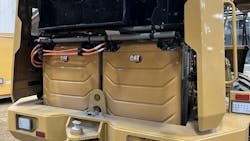Mining Minerals for High-tech Materials with Autonomy and Mollusks
Every day, the race is on to secure rare earth minerals for the manufacture of materials used for EVs and electronics for now and the future—and even mollusks are being studied for what they may bring to the quest.
Trade troubles with China and keeping them from having a monopoly on such materials are only part of the reason. Production of tech items is going nowhere but up for construction machinery and most everything else, so mineral production will eventually go 24/7.
Ramping up U.S. production
Locking up access to these types of materials is so important that the U.S. Department of Defense (DoD) in July bought a multimillion-dollar stake in MP Materials, a Las Vegas-based company that mines rare earth magnets.
According to Reuters, the DoD will become MP’s biggest shareholder, help the company up its production, and establish a floor price well above the current Chinese market price. Rare earths are a group of 17 metals used to make magnets, and MP operates the only rare earths mine in the U.S. Magnets are used to help provide power for even more manufacturing.
It's leverage versus China as well as insurance for future tech production.
More on EVs
- Benefits of home charging.
- Ryan Central prepares for possible tariffs.
- Volvo electric earthmovers available in North America.
In our industry, Komatsu has partnered with Pronto to deploy the latter firm’s autonomous haulage technologies to the North American market for mineral production. Komatsu’s Smart Quarry Autonomous is powered by Pronto.
“Today, by combining Komatsu’s trusted hardware and vast support network with Pronto’s scalable, intelligent autonomous platform, we are fundamentally changing the game," said Anthony Levandowski, CEO of Pronto. "We’re enabling a future of enhanced safety and incredible productivity that is now accessible to quarries of all sizes.”
The OEM-agnostic solution will allow quarry operators to retrofit existing Komatsu vehicles or purchase new trucks equipped with Pronto’s self-driving system, enabling 24/7 operation.
Help from sea creatures?
An international team of scientists, including materials specialists from the University of California, Irvine and two Japanese universities, may have found a blueprint for more sustainable manufacturing of advanced materials for use in batteries, fuel-cell catalysts, and semiconductors.
It’s a result of their study of how chitons, mollusks that feed on algae growing on seashore rocks, develop such hard, wear-resistant and magnetic teeth.
In its study, the team unveiled the process by which chiton-specific, iron-binding proteins called RTMP1 are transported into newly forming teeth through nanoscopic tubules called microvilli.
Where and when the proteins are deposited is precisely controlled, ensuring that the creatures develop a hard, strong and tough dental architecture that enables them to perform the repetitive abrasive motions on which their lives depend.
“Chiton teeth, which consist of both magnetite nanorods and organic material, are not only harder and stiffer than human tooth enamel, but also harder than high-carbon steels, stainless steel, and even zirconium oxide and aluminum oxide—advanced engineered ceramics made at high temperatures,” said study co-author David Kisailus, UC Irvine professor of materials science and engineering.
“Chiton grow new teeth every few days that are superior to materials used in industrial cutting tools, grinding media, dental implants, surgical implants, and protective coatings, yet they are made at room temperature and with nanoscale precision. We can learn a lot from these biological designs and processes,” he said.
Kisailus said the project has improved humanity’s understanding of cellular iron metabolism while providing insight into the synthesis of next-generation advanced materials.
New teeth in days
“The fact that these organisms form new sets of teeth every few days not only enables us to study the mechanisms of precise, nanoscale mineral formation within the teeth, but also presents us with new opportunities toward the spatially and temporally controlled synthesis of other materials for a broad range of applications, such as batteries, fuel cell catalysts, and semiconductors,” Kisailus said.
“This includes new approaches toward additive manufacturing—3D printing—and synthesis methods that are far more environmentally friendly and sustainable.”
Perhaps the ground-engaging tools for mineral mining will receive a surprise boost from mollusks.
About the Author
Frank Raczon
Raczon’s writing career spans nearly 25 years, including magazine publishing and public relations work with some of the industry’s major equipment manufacturers. He has won numerous awards in his career, including nods from the Construction Writers Association, the Association of Equipment Manufacturers, and BtoB magazine. He is responsible for the magazine's Buying Files.



